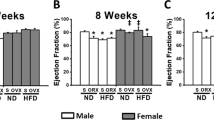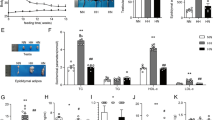Abstract
OBJECTIVE: Withdrawal of testosterone prevents the development of hyperglycaemia in male Otsuka-Long-Evans-Tokushima Fatty (OLETF) rats, a model of non-insulin-dependent diabetes mellitus (NIDDM), but the exact mechanism has not been established. The present studies were undertaken to examine a possible role of testosterone in the development of obesity in young OLETF rats who have not shown marked hyperphagia.
METHODS: Body weight, food intake and circulating concentrations of metabolic factors including immunoreactive leptin (IRL) were measured at five weeks of age in young male OLETF rats and their lean controls, Long-Evans-Tokushima-Otsuka (LETO) rats. At six weeks of age, both LETO and OLETF rats were bilaterally orchiectomized (Orchx) and half of each group implanted with a silastic tube containing testosterone. After a three week observation period, all animals were killed and circulating concentrations of metabolic factors and the ob gene expression in retroperitoneal white adipose tissues were measured.
RESULTS: Body weight and 24 h food intake were already increased in OLETF rats at five weeks of age. Serum testosterone concentrations were significantly lower in OLETF rats than in LETO rats. Expression of the ob gene was significantly decreased in the retroperitoneal white adipose tissue of OLETF rats, and their serum IRL concentrations were lower. Food intake and body weight gain for three weeks after the operation were significantly lower in the Orchx group of OLETF rats than in the sham-operated group. Hyperglycaemia, accompanied by hyperinsulinaemia, was attenuated by orchiectomy in OLETF rats. Circulating IRL concentrations were significantly higher in OLETF rats than in LETO rats and decreased by orchiectomy. Testosterone supplement reversed all of the changes caused by orchiectomy in OLETF rats. In contrast, the changes, which were observed after orchiectomy in OLETF rats, were not obvious in LETO rats.
CONCLUSION: The present data indicate that testosterone plays a role in the development of obesity and NIDDM in young OLETF rats, but that changes of leptin production in white adipose tissue may not be important in the development of obesity in young OLETF rats.
This is a preview of subscription content, access via your institution
Access options
Subscribe to this journal
Receive 12 print issues and online access
$259.00 per year
only $21.58 per issue
Buy this article
- Purchase on Springer Link
- Instant access to full article PDF
Prices may be subject to local taxes which are calculated during checkout
Similar content being viewed by others
Author information
Authors and Affiliations
Rights and permissions
About this article
Cite this article
Shimizu, H., Ohtani, KI., Uehara, Y. et al. Orchiectomy and response to testosterone in the development of obesity in young Otsuka-Long-Evans-Tokushima Fatty (OLETF) rats. Int J Obes 22, 318–324 (1998). https://doi.org/10.1038/sj.ijo.0800586
Received:
Revised:
Accepted:
Published:
Issue Date:
DOI: https://doi.org/10.1038/sj.ijo.0800586
Keywords
This article is cited by
-
Importance of oestrogen receptors to preserve functional β-cell mass in diabetes
Nature Reviews Endocrinology (2012)
-
Hormonal regulation of appetite and body mass in patients with advanced prostate cancer treated with combined androgen blockade
Journal of Endocrinological Investigation (2001)



